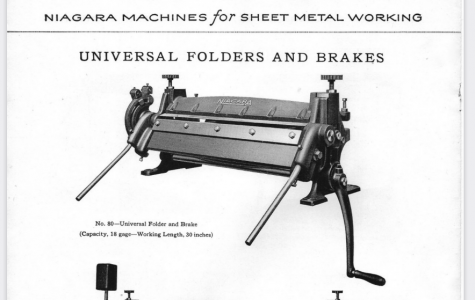- Joined
- Aug 29, 2016
- Messages
- 857
Five years ago when I was cleaning up the late father in law's shop, I unearthed this big lump of cast iron that was attached to a makeshift cart made from lawn mower parts. It was an impressive cart, even had a tiller and steerable axle. The iron looked like it might be a metal brake. It was also buried in ... stuff. And was half wedged under the 1928 Model AA frame and the '23 Graham Bros firetruck. As a path was cleared, the cart with contents got rolled up under the shelving next to the Onan generator (mounted on another home-brew cart) for future inspection. Then health and other things conspired for four plus years.
I dug it out this past week, cleared it off, and hoisted it up onto the shelf. It is indeed a metal brake. But it's not the finger brakes I remember from high school shop. A far bit of duck-duck-go-fu led me to a single picture in a pamphlet that is an exact match. Exact. A Niagara Univerisal Folder/Brake #80. This is the only reference I can find. Anywhere!

Does anyone have any idea what I have, what it was used for? And possibly what I could use it for beyond a basic brake?
I dug it out this past week, cleared it off, and hoisted it up onto the shelf. It is indeed a metal brake. But it's not the finger brakes I remember from high school shop. A far bit of duck-duck-go-fu led me to a single picture in a pamphlet that is an exact match. Exact. A Niagara Univerisal Folder/Brake #80. This is the only reference I can find. Anywhere!

Does anyone have any idea what I have, what it was used for? And possibly what I could use it for beyond a basic brake?
